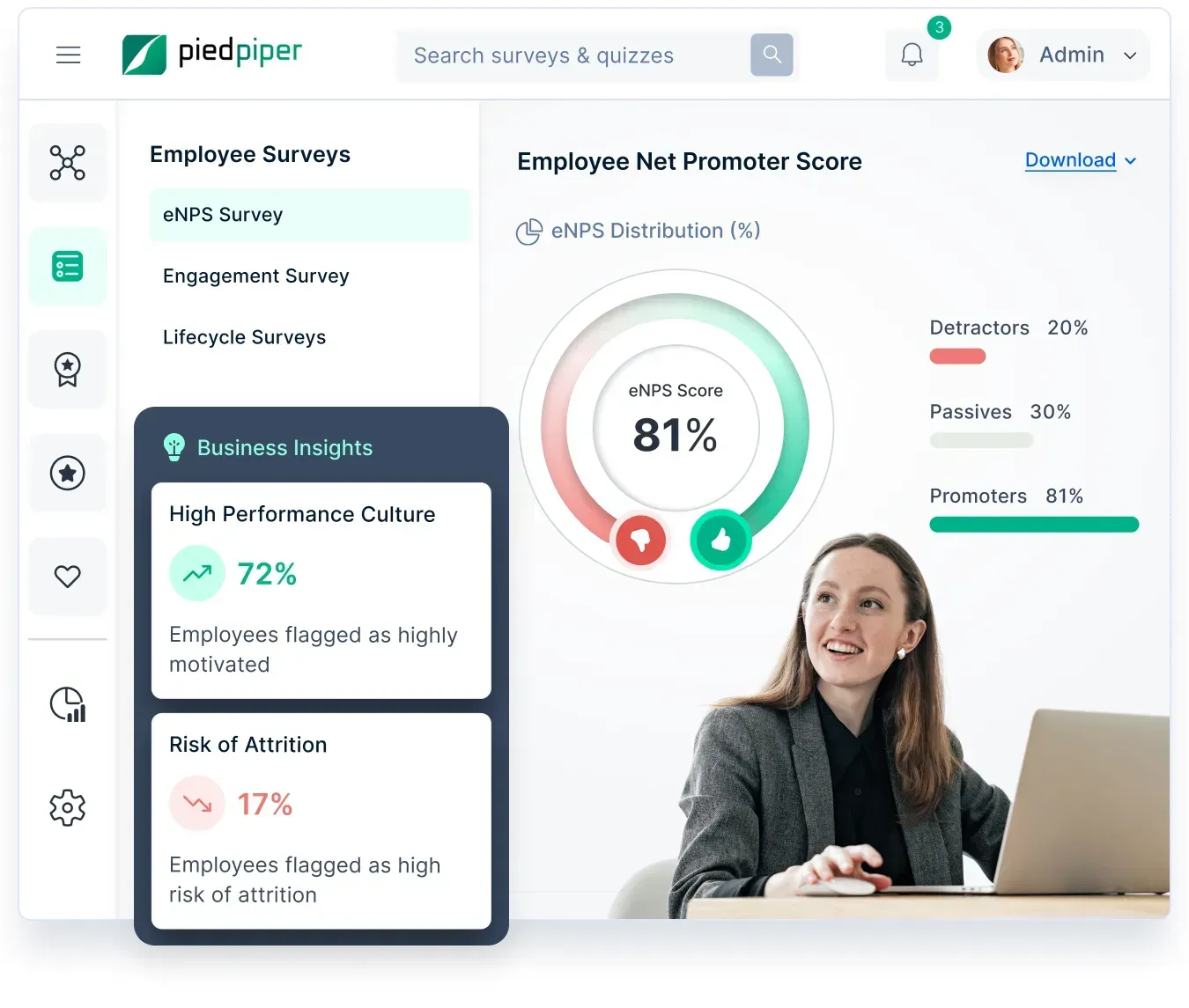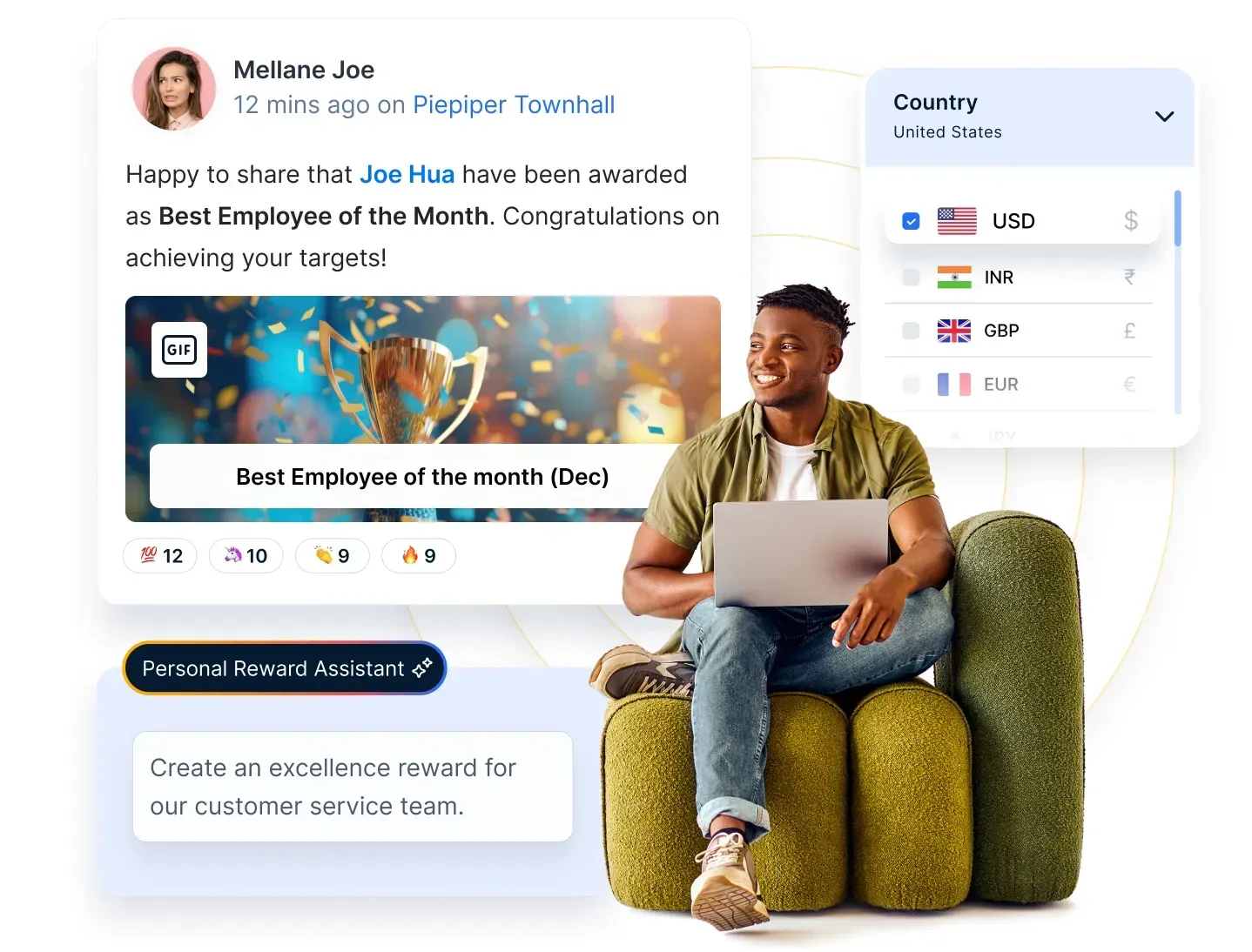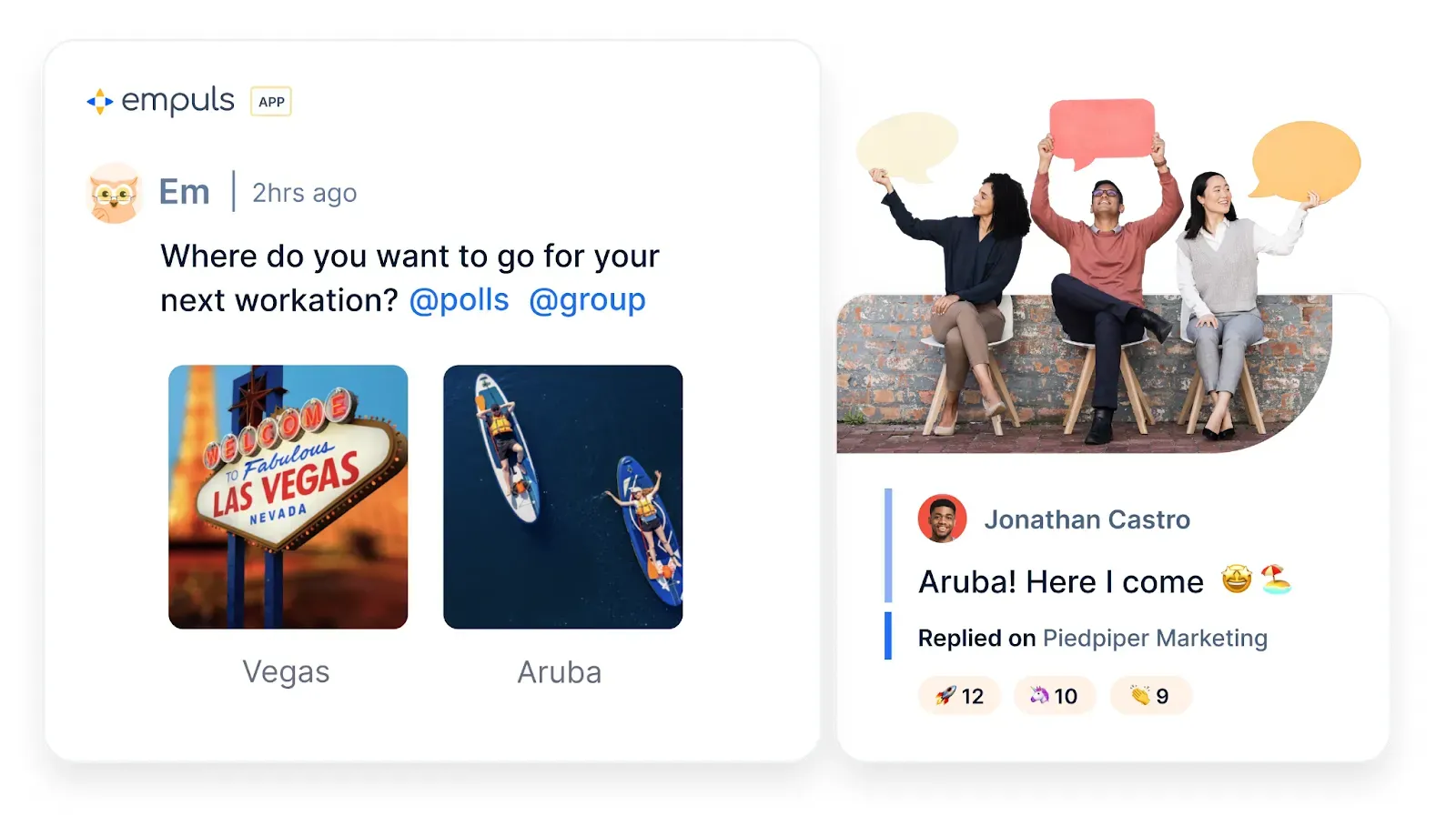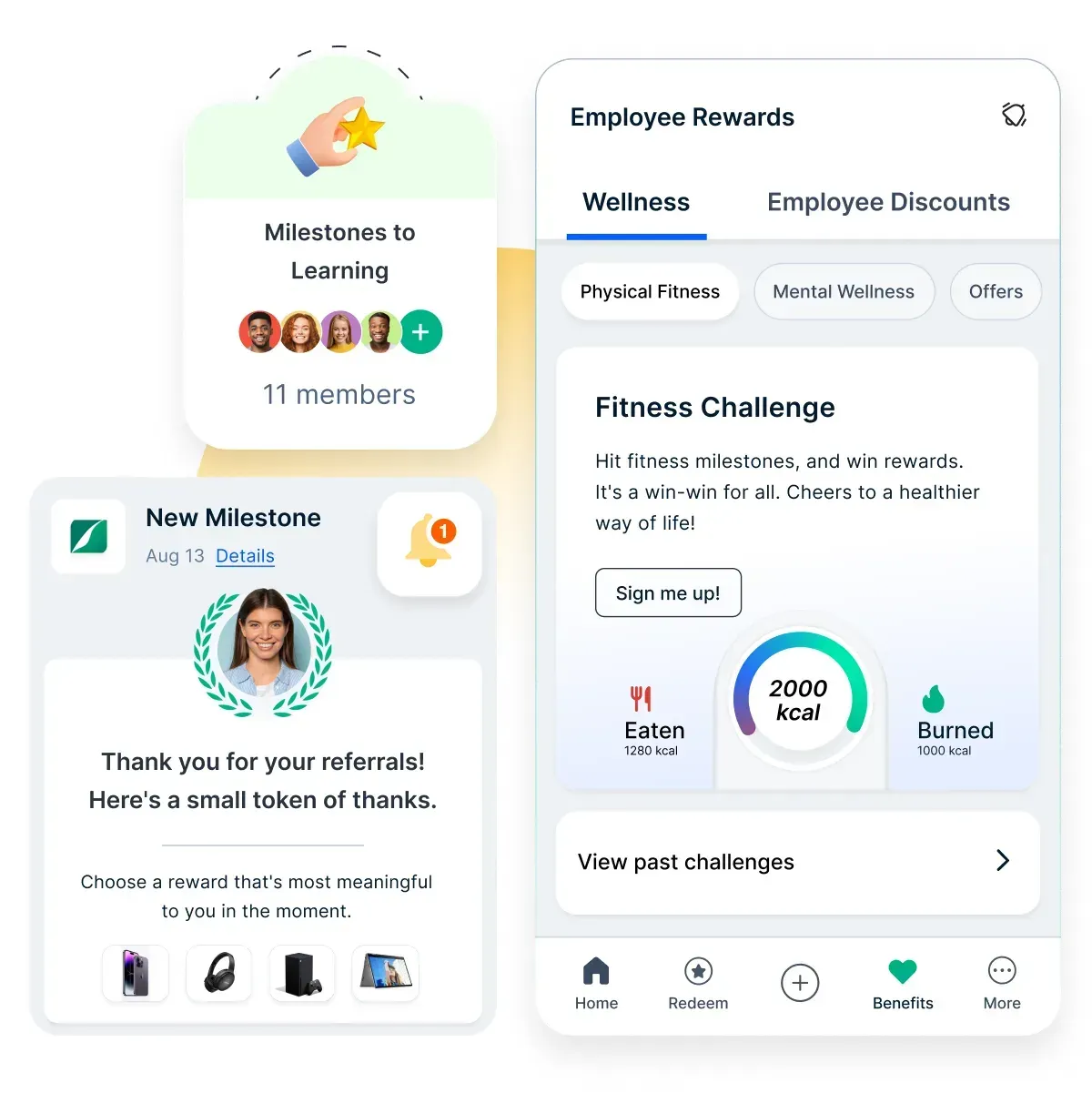Supporting Employee Wellbeing During Furlough and Redundancy
Furlough and redundancy don’t have to mean disconnection. Learn how to support employee wellbeing with structured communication, empathy, recognition, and platforms like Empuls that keep your people engaged, through and beyond uncertainty.
On this page
- What is employee wellbeing in the context of furlough and redundancy?
- Why should organizations prioritize employee well-being during furlough or redundancy?
- When should you start supporting employees?
- Where can you support them? (touchpoints for ongoing wellbeing)
- Who should be responsible for managing employee well-being?
- How to support employee wellbeing during furlough and redundancy
- Combating the challenges while placing the employees on furlough
- Empuls spotlight: How to enable ongoing support and recognition
- Conclusion: Rebuilding trust and stability starts with people
Furlough and redundancy are two words no employee wants to hear. Yet, in times of crisis, such as the COVID-19 pandemic, they have become unavoidable realities for many organizations. While these measures are often necessary to protect business continuity, their emotional and psychological toll on employees is immense.
Employees facing furlough often deal with isolation, uncertainty, and a loss of identity tied to their roles. Those made redundant may experience anxiety about their financial stability and fear of what the future holds. If left unsupported, these emotional stresses can ripple across the rest of the workforce, damaging trust, morale, and long-term loyalty.
That’s why employee wellbeing during these periods shouldn’t be an afterthought. It should be part of the transition strategy itself.
Whether you're preparing employees for temporary leave or navigating difficult redundancies, taking care of their mental and emotional well-being is essential. When you support people through their most vulnerable moments, you don’t just protect their health—you preserve the culture and humanity of your workplace.
What is employee wellbeing in the context of furlough and redundancy?
Employee well-being goes far beyond physical health. In the context of furlough and redundancy, it means protecting a person’s mental clarity, emotional security, and sense of self-worth during one of the most vulnerable periods of their professional lives.
When an employee is furloughed, they’re not just stepping away from daily work. They’re temporarily separated from a routine that gave them structure, purpose, and social connection. Redundancy, on the other hand, can hit even harder, removing that connection completely and leaving people to navigate the unknown alone.
Well-being in this context is about ensuring employees feel respected, informed, and cared for, even when they are not actively working. It’s about addressing their financial fears, acknowledging their emotional stress, and supporting their ability to stay productive, confident, and mentally healthy.
Support can take many forms—honest communication, access to mental health services, opportunities to upskill, or simply a message that says, “We haven’t forgotten you.” Every gesture contributes to preserving dignity and reducing the emotional weight of the transition.
Why should organizations prioritize employee well-being during furlough or redundancy?
Supporting employees through furlough or redundancy isn’t just the right thing to do—it’s also a smart move for long-term business health. During times of uncertainty, people remember how they were treated. If support and transparency are lacking, trust erosion can affect not just morale but also your employer brand, retention, and even future recruitment.
Here’s why investing in employee wellbeing during these transitions matters:
- Protects mental health: Studies have shown a spike in anxiety, depression, and burnout during furloughs. Prioritizing well-being prevents short-term stress from turning into long-term damage.
- Reinforces trust in leadership: Employees who feel supported during tough times are more likely to stay loyal. Even those who leave will speak positively about the company’s handling of the situation.
- Preserves team morale: Furloughs or redundancies affect more than the person directly involved. Supporting one employee well sends a signal to the rest of the team that people matter.
- Reduces the cost of rehiring and retraining: When employees feel valued—even during transitions—they are more likely to return or recommend the organization to others, thereby reducing future hiring friction.
- Improves your reputation: Candidates and clients alike notice how companies act under pressure. Organizations that treat people with dignity during crises build stronger brands.
- Sets a positive precedent for future change: Change is inevitable. How you manage this change will influence how people respond the next time a disruption comes.
Supporting wellbeing during furlough and redundancy isn’t about avoiding difficult conversations. It’s about having those conversations with empathy, clarity, and intention.
When should you start supporting employees?
The best time to support employee wellbeing is before the crisis reaches their inbox. Yet in many organizations, support is reactive, coming only after uncertainty has already caused stress, confusion, or disengagement.
Support should begin the moment furloughs or redundancies become a possibility, not a reality. Even before official decisions are made, keeping employees informed about the business climate builds emotional preparedness and trust.
Here’s how proactive timing makes a difference:
- Pre-announcement: Begin by sharing the broader context early. Help employees understand the pressures the business is facing and what options are being considered. This builds psychological safety, even if outcomes are uncertain.
- At the time of announcement: Deliver the news with honesty, empathy, and clarity. Avoid vague messaging or overly optimistic promises. Let people ask questions and process the information with support.
- During furlough or transition: Maintain regular communication. Utilize tools like Empuls to conduct pulse surveys, share updates, and keep employees engaged through small yet meaningful interactions.
- Before returning or exiting: Plan individual check-ins for furloughed employees upon return and for redundant employees upon exit. Offer career guidance, mental health resources, and clear roadmaps so they don’t feel abandoned.
When support starts early and continues throughout the transition, employees are less likely to feel forgotten. Instead, they think guided—and that changes everything about how they experience uncertainty.
Where can you support them? (touchpoints for ongoing wellbeing)
Supporting employee wellbeing during furlough or redundancy doesn’t require grand gestures. What matters is where and how often you show up. Many employees feel disconnected simply because they don’t know where to turn for support once they're out of their regular work loop.
To keep employees feeling valued and connected, organizations need to be present across multiple touchpoints. These aren’t just communication channels—they’re emotional anchors.
Here are some key touchpoints where you can make a meaningful impact:
- Internal communication platforms: Utilize tools like Empuls to share updates, broadcast leadership messages, and keep furloughed employees informed about the company's progress. This visibility helps reduce feelings of isolation.
- Manager check-ins and team huddles: Personal connection from a manager goes a long way. A quick monthly or bi-weekly call can help employees feel remembered and emotionally supported.
- Employee Assistance Programs (EAPs): Provide access to counseling, financial advice, and mental wellness resources. Ensure furloughed or exiting employees know how to use these services—even after they leave.
- Learning and development systems: Keep the door open for skill-building. Whether it’s online training or a recommended reading list, learning can be a valuable motivator during uncertain times.
- Community channels and social spaces: Encourage peer-to-peer support through virtual groups or interest-based communities. This can help employees stay socially engaged, even when they are away on professional assignments.
- Well-being surveys and feedback forms: Collect insights regularly. Use pulse checks to assess stress, morale, and motivation, and then act quickly on the insights you gain.
When support is embedded across these touchpoints, employees don’t have to seek reassurance—it comes to them. And in times of furlough or redundancy, that consistent presence can make all the difference.
Who should be responsible for managing employee well-being?
Employee wellbeing during furlough and redundancy isn’t just an HR checkbox. It’s a shared responsibility—one that spans across people managers, senior leadership, HR teams, and even peers. Everyone plays a part in creating an environment where employees feel supported, regardless of their phase.
Here’s how different stakeholders contribute:
- HR teams: HR sets the foundation by creating and communicating policies, coordinating access to EAPs, and ensuring employees know their rights and resources. They also monitor pulse surveys, manage training access, and design return-to-work or exit plans that are humane and respectful.
- People managers: Managers are the closest point of contact for employees. Their role is to maintain regular check-ins, lead with empathy, and identify signs of distress early. A quick message or phone call from a manager can go further than a formal announcement from HR.
- Senior leadership: Leaders must model transparency and vulnerability. Sharing the business outlook with honesty helps employees understand the bigger picture. Acknowledging employee concerns publicly shows that well-being is being considered at the highest level.
- Peers and colleagues: Encourage a culture where coworkers support one another. Whether through virtual communities or simple messages of encouragement, peer connections are vital to reducing feelings of isolation.
- Technology partners like Empuls: Platforms like Empuls give everyone, from HR to team leads, the tools to listen, appreciate, and respond quickly. Whether it’s a pulse check, a recognition message, or a team challenge, Empuls keeps wellbeing active and visible across the organization.
In short, supporting wellbeing isn’t a department. It’s a culture. When every role contributes, employees feel surrounded, not forgotten.
How to support employee wellbeing during furlough and redundancy
Supporting employee wellbeing through furlough or redundancy means showing up with clarity, consistency, and compassion—at every step of the journey. While these periods are filled with uncertainty, the actions you take as an organization can help ease emotional burdens, reduce anxiety, and strengthen long-term loyalty.
Here’s a detailed guide to doing it right:
1. Communicate early and transparently
Silence breeds fear. Whether you’re planning furloughs, announcing redundancies, or navigating ongoing changes, clear and timely communication is key. Explain the “why,” acknowledge the impact, and be honest about what the future looks like—even if you don’t have all the answers yet.
- Host live virtual town halls or video messages from leadership
- Send email updates with timelines, FAQs, and support contacts
- Use Empuls to centralize updates and reduce misinformation
2. Offer access to mental health and EAP services
The emotional impact of losing work—even temporarily—can be profound. Depression, anxiety, and burnout are common among furloughed or redundant employees. Ensure they have access to mental health support, and make it easy to use.
- Reintroduce EAPs with clear instructions and links
- Share mental wellness content like meditation, journaling, and self-care guides
- Offer virtual therapy sessions or webinars on stress and resilience
3. Provide opportunities to upskill and stay engaged
Furloughed employees may not be working, but they can still grow. Providing access to skill-building resources keeps them engaged, improves their confidence, and ensures they return stronger if or when they rejoin.
- Create curated learning paths or online training libraries
- Invite furloughed employees to join existing learning initiatives
- Recognize those who complete courses via Empuls with badges or shoutouts
4. Encourage volunteering and purposeful activities
Idle time can lead to rumination and a low sense of self-worth. Encourage employees to find meaning through volunteering or creative personal projects. Doing good often restores a sense of control and optimism.
- Share local or virtual volunteering opportunities
- Highlight employee stories to inspire others
- Reward participation with appreciation points via Empuls
5. Schedule regular check-ins and wellbeing conversations
Make personal contact a habit. Whether through a quick call, text, or email, check-ins remind employees they haven’t been forgotten. These interactions are especially meaningful when they come from direct managers or team leads.
- Book monthly 1:1s with furloughed or at-risk employees
- Use Empuls to send wellbeing pulse surveys and mood check-ins
- Track patterns of concern and act before they escalate
6. Set personal and professional goals with structure
One way to combat uncertainty is by helping employees refocus on what they can control. Encourage them to set SMART goals—specific, measurable, achievable, realistic, and time-bound. This keeps their mindset forward-looking and helps preserve routine.
- Host a virtual goal-setting session or workshop
- Share templates and examples that employees can build on
- Recognize progress and effort publicly through your internal tools
7. Recognize contribution and loyalty—even during time away
Furloughed or redundant doesn’t mean forgotten. A simple message of appreciation, a team newsletter mention, or a values-based badge can go a long way in reminding employees they are still seen and valued.
- Use Empuls to send digital recognitions to offboarded or furloughed staff
- Celebrate anniversaries, birthdays, or past achievements
- Highlight employee stories that showcase resilience and contribution
8. Prepare for a thoughtful and safe return to work
If furloughed employees are coming back, don’t treat it like a reset button. Ease them in. Reintroduce them to workflows, explain what's changed, and acknowledge that they may feel out of sync.
- Plan 1:1 re-onboarding sessions with managers
- Offer flexibility for the first few weeks (reduced hours, hybrid work)
- Reinforce health and safety protocols so employees feel safe returning
Supporting employee wellbeing during furlough or redundancy is not just about doing damage control. It’s about helping people find stability, dignity, and a sense of direction during a time when everything else feels unsteady.
Combating the challenges while placing the employees on furlough
Placing employees on furlough presents numerous challenges. Here are some ways to ensure that you do your best to support your employees despite the difficulties.
1. Place emphasis on job security
It can be challenging to demonstrate job security during times of uncertainty. But, it is vital to show your employees that you are trying to keep people employed.
It is crucial to highlight all the positives from the furlough scheme. For example, maybe your business could avoid redundancies by participating in the furlough scheme.
Your employees may not see this unless you tell them. Remind employees that it is a temporary solution and that, in time, they will be able to return to work. Although don't be too quick to make promises that you feel you may not be able to keep.
2. Plan ahead
The current situation will not last forever, so it’s a good idea to plan for when furloughed employees return to work. Setting up a one-to-one session where you discuss returning to work will help ease them back into the workplace environment.
Your aim should be to make their first few days at the office more comfortable. Ask them how they feel and reassure them about getting back to speed with their role.
3. Try to find structure
For many employees, work provides a structure to their daily lives. They have a day-to-day routine, which includes going to the office. If that is out of the equation, they might face some challenges with productivity and purpose.
Employees need to be encouraged to find structure in their furloughed state. Lifestyle blogger Rhianna Olivia provides some tips on how to stay productive while on leave. She emphasizes that furloughed employees should have a weekly and daily routine, so they don't feel like they’re taking three steps backward.
4. Employee mental health should be a priority
During uncertain times, mental health often takes a backseat. However, you must make mental health a priority and combat any feelings of demotivation, inadequacy, and low self-worth.
A useful way to keep your employees motivated is to encourage them to create SMART goals for themselves. SMART stands for specific, manageable, achievable, realistic, time-bound goals. With SMART goals, they will have a structured way to keep motivated and work on their self-development.
5. Make returning to work easy
Employees may have anxieties about returning to work, some even suffering from "furlough fever." So, you need to ensure that a return to work is as smooth and hassle-free as possible.
Remember, employees have been out of their usual routine for some time. As such, you are easing them into things slowly is important. It’s all about making sure that your employees are comfortable and ready to get back to work.
With the virus still in circulation, you must ensure that your employees feel safe returning to work.
Therefore, ensure that you have all the necessary safety procedures in place so that your employees can feel more comfortable and secure in the workplace.
Empuls spotlight: How to enable ongoing support and recognition
Furloughs and redundancies can create emotional distance, not just physically, but culturally. That’s why it’s important to maintain a sense of connection, belonging, and support throughout the transition. This is where Empuls plays a decisive role in helping HR teams and managers stay engaged with employees, even when they’re away from the daily workflow.
Empuls isn’t just a tool for recognition. It’s a full-fledged engagement platform designed to keep communication flowing, morale steady, and wellbeing at the center of your culture, no matter the circumstances.
Here’s how Empuls supports employee wellbeing through furlough and redundancy:
1. Unified internal communication hub
Keep employees informed, aligned, and involved with company-wide updates, leader messages, or policy changes. Empuls’s social intranet makes it easy to share information in a way that’s timely, transparent, and human.
2. Pulse surveys for continuous check-ins
Utilize quick mood surveys or structured feedback tools to gauge the emotional state of your workforce during furlough or following redundancy announcements. The data helps you detect early signs of disengagement and emotional strain, enabling HR teams to respond more effectively and promptly.

3. Recognition that reaches everyone
Even when employees aren’t actively working, recognition shouldn’t stop. Empuls enables peer-to-peer shoutouts, manager-led appreciation, and value-driven recognition through badges and points. You can celebrate past contributions or support personal growth efforts while employees are on leave.

4. Rewards that fit the moment
Instead of large bonuses, use Empuls to issue meaningful non-monetary rewards—digital gift cards, skill-building incentives, or curated wellness experiences. This provides employees with a morale boost without straining the company's finances during uncertain times.

5. Employee communities and peer engagement
Let furloughed employees stay connected through interest groups, volunteering challenges, and peer recognition circles. These virtual spaces help them feel part of the larger team, even when they’re physically away.

6. Campaigns to drive purpose and positivity
Run customized campaigns, such as wellness check-ins, gratitude drives, or mental health awareness weeks. Empuls enables you to automate, track, and scale these efforts, ensuring that no one slips through the cracks.
Empuls gives companies the tools to act with empathy at scale. It ensures that furloughed and redundant employees are not just supported—they're still seen. When the dust settles, and people return or move on, they’ll carry that experience of care with them for life.

Furloughs and redundancies are tough—but your response doesn’t have to be. Use Empuls to stay connected, show appreciation, and keep morale alive. From recognition to wellness check-ins, give your people the care they deserve.
👉 Explore Empuls Today
Conclusion: Rebuilding trust and stability starts with people
Furloughs and redundancies are always difficult. But how you support your people through them defines the kind of culture you’re building—one that simply survives turbulence, or one that grows stronger through it.
When you place employee wellbeing at the center of your transition strategy, you do more than soften the impact. You convey trust, care, and a long-term commitment. You show employees—whether staying, leaving, or temporarily away—that they are valued not just for their output, but for who they are.
It doesn’t take massive budgets. It takes structure, empathy, and consistency. With tools like Empuls, you can stay connected, offer recognition, listen deeply, and build a culture where wellbeing isn’t reactive. It’s embedded.
Furlough and redundancy may be unavoidable at times. But disengagement, mistrust, and silence? Those are choices. And when you choose care, your people will remember it long after the crisis has passed.


















